These Ivey graduates are risk takers who push the limits in their spare time, pursuing dangerous hobbies for more than just the thrills.
The Macau Tower Bungy Jump is 764 feet high, the highest in the world. Erwin Szeto (pictured below), HBA ’02, is very afraid of heights. On the day he did the Jump, he was also recovering from food poisoning picked up during a holiday in Thailand. “At least four times while I was being buckled in I thought about how I was going to get out of it,” he says. “But my wife had gone first, so there was no way I couldn’t do it.”
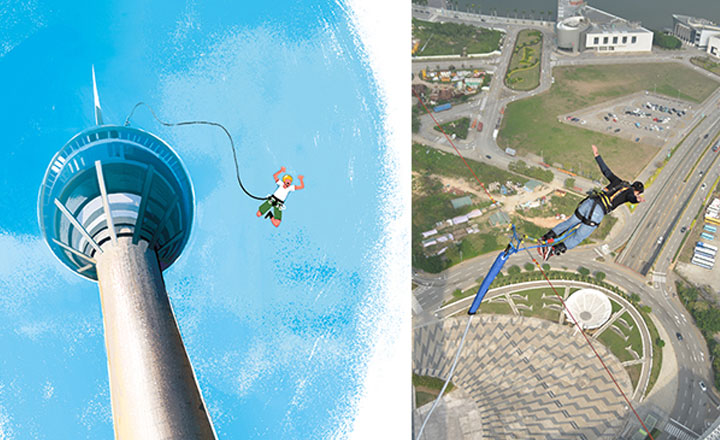
Szeto is a risk taker. He has also completed Toronto’s CN Tower EdgeWalk, gone skydiving, scuba diving and white water rafting, and rappelled down a waterfall.
He is certainly not alone. Many Ivey graduates pursue hobbies that most of us think of as dangerous. They end up with great stories to tell, but there’s more to it than that. “You think you have a limit,” says Szeto, “and then you push past it. You realize that you can push yourself in business too.”
Justin Aniballi, EMBA ’99, doesn’t share Szeto’s fear of heights. Quite the contrary—he finds the sight of a high vertical rock face irresistible. “When I’m around any kind of rock formation that looks interesting, I want to scramble up it and see if I can get to the top.”
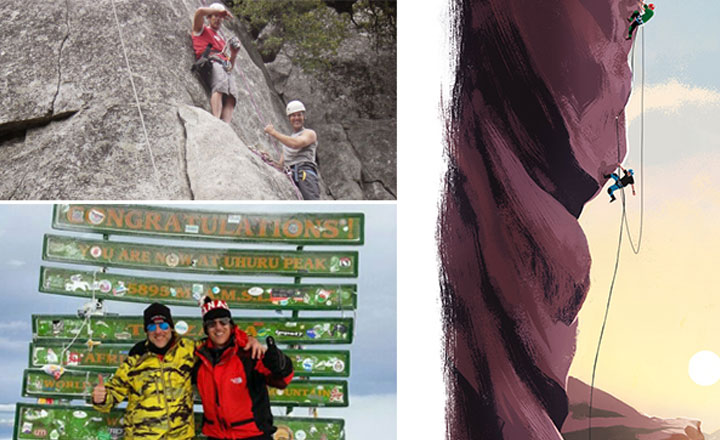
Justin and his twin brother Michael (pictured above), also EMBA ’99, have done lots of risky things together, including skydiving, track racing, motocross, snowboarding, surfing and scuba diving. They started climbing in their early 20s at indoor climbing gyms in Toronto. “I was a single father at the time I did the Executive MBA so I had to get really good at managing my time,” says Michael. “When I was finished, I couldn’t believe how much spare time I had!” To fill the time, he also earned his pilot’s licence and competed in several triathlons.
Justin and Michael climbed Mount Kilimanjaro in 2014, and scaled Mount Rainier in Washington State last August. “These climbs are about pushing your body to its limits,” says Justin. “Summit day on Kili is 18-plus hours, with nothing but water, trail mix and a protein bar.” Rainier involves a dangerous 12-hour trek across two glaciers, calling for the use of crampons and ice axes, and precarious aluminum ladders stretched across 250-foot-deep crevasses.
Those aluminum ladders also featured in Annette Ebbinghaus’s year of adventures to celebrate turning 50. Ebbinghaus (pictured below), MBA ’93, an avid outdoor enthusiast, cyclist, runner, and skier, set out to do “fun things that required some level of fitness and going outside the comfort zone” with at least 50 friends over the course of the year.
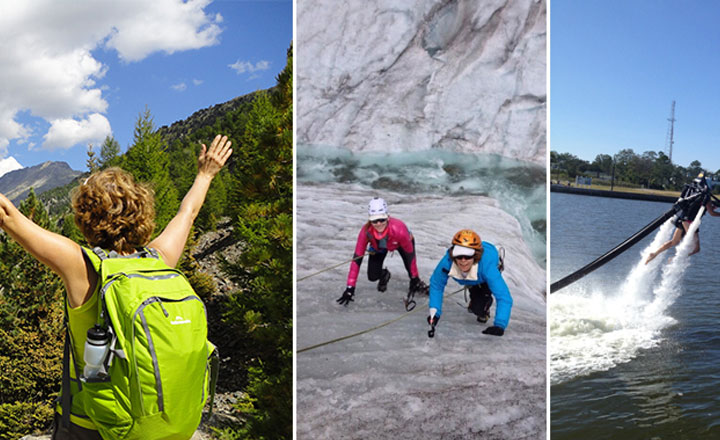
Currently living in Switzerland, Ebbinghaus had a variety of events on the list—multi-day cycling trips, surfing, zip lining and mountain adventures, such as snowshoeing, climbing, ski randonnée and high-altitude, multi-day hiking. During a workshop on glacier climbing, she found herself scaling 300 feet of aluminum ladders bolted to a vertical rock face. “I was the last one in our group coming up the ladders and there was thunder and lightning going on above us,” she says. “I had to focus, breathe and count each rung—10 at a time —to get myself to the top.”
At another point in the year, a group of friends surprised her with a jetpack experience. Strapped into a metal cage, she was propelled into the air by water shooting out from the back of the pack. “You have to watch your balance—if you get unbalanced, you fall, and if you don’t pull the emergency lever quickly enough, you get dragged under. It was the craziest thing I did… and I’d like to try it again.”
Paula Gaul, MBA ’99, does her dangerous hobby at high altitudes too— but with her, it’s also a job. She and her husband Kieren own Big Red Cats, a cat skiing company in Rossland, BC. Gaul was a captain in the Canadian Army before doing her MBA. After graduating, she spent five months sailing a yacht in the South Pacific. She met her husband while working in Australia and they launched Big Red Cats in 2003.
Cat skiing is similar to heli-skiing, except that skiers are taken up the mountain in a tracked vehicle designed to move on snow. Avalanches are always a risk. Gaul once saw a man carried down the slope and buried by an avalanche, although he was quickly found and dug out. “And I’ve been in some little stuffs (small snow displacements) that could have turned into something bigger but never did.” Big Red Cats emphasizes safety and has guides regularly monitoring the area. Says Gaul, “Accidents do happen, even if you do everything right, so we make sure to choose staff who are able to mitigate that risk through terrain selection and guest training.”
James Gardner (pictured below), HBA ’89, has rediscovered a risky pastime that he first learned to love as a summer camper: white water canoeing in the Arctic. Now living in Boston, he reconnected with a former camp counsellor who now operates an outfitting operation, Wanapitei Canoe & Northern Outdoor Expeditions. For the past four summers, he has spent several weeks paddling some of the most remote waters on Earth
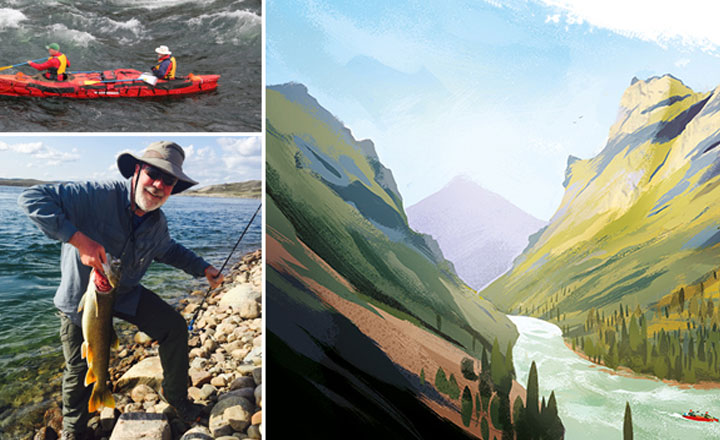
Gardner admits that the remoteness is itself a risk. “If you really hurt yourself, it could take a day or more to be evacuated.” The trips involve navigating through rocks and rapids in water that is often still frozen in parts. And of course, there is the wildlife—grizzlies, polar bears, wolves, wolverines, caribou and more. “We’ve seen a grizzly mother and cub from a distance, but they’re usually quite shy and skitter away,” he says. Even flying in or flying out can be exciting, Gardner says. “There are no runways or airports. The pilots have a compass bearing and then they just circle around looking for a flat spot that isn’t too mushy or wet.”
Like Gardner, Peter Andrews (pictured below), MBA ’84, has rediscovered a dangerous hobby of his youth. A car enthusiast from his early teens, Andrews built and raced cars for several years before career and family intervened. Six years ago, a friend asked him to become his race partner. “Once I went to the track and tried the car, I was hooked,” he says. With his children finished university, he realized he had the time and resources to get involved.
Andrews races in a Formula 1600 Series in Quebec and Ontario. With track racing, he says safety standards are high. “I’ve had several crashes and not hurt myself even a little bit—but I’ve certainly had to put cars back together.” He and his partner also participate in race rallying, a sport that involves driving fast on public roads. “Race tracks are designed to go fast—everyone is going the same direction, you know the curves, and there are barriers and rails to keep you out of trouble,” he explains. “With rallying, you drive by instinct, experience and instructions from your navigator.”
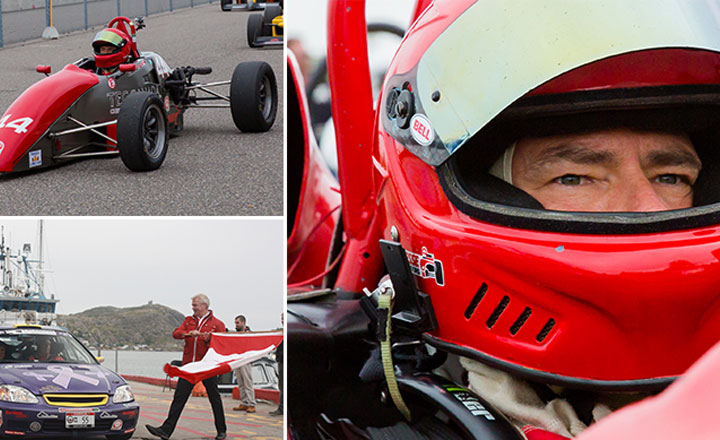
Andrews and his partner participated in the 2014 Targa, a race rally over some 2,000 kilometres of back roads in Newfoundland. Mechanical problems prevented them from finishing, so they are keen to participate again in 2016.
So why does Andrews choose to participate in such a dangerous sport? “I’ve pushed the limits of my capabilities in business, and I take great satisfaction from success,” he says. “Racing is an opportunity to challenge myself physically and mentally. I think it helps keep my mind sharp and develops the stamina required for business.” He pauses, and then adds, “I’m not sure my life insurance company agrees.”
For Gardner, paddling in remote locations is a way to “awaken his spirit.” He says, “There’s an element of risk and exhilaration as you navigate through a set of rapids, knowing it’s you against the river. It’s exciting to do something you’re not sure you can do.”
Ebbinghaus says pushing herself mentally and physically helps her deal positively with setbacks in life. “When I’m confronted with challenges, I know that I will find a way around, over or through them. I live my life with a great deal of hope and optimism.” For Gaul, cat skiing is about the thrill of the unknown. “When the cat drops you off in the wilderness, there’s a sense of discovery—you don’t know what’s behind the next tree and you get to choose your own adventure to the bottom.”
Michael Aniballi jokes that he wants his parents to have good stories to tell their friends. Then he adds thoughtfully, “But what really drives me is that I’m trying to do as much as I can before I run out of time.”
Justin says rock climbing helps him discover the child within. “There’s a certain unfiltered joy in it,” he says. “It’s an instant time machine back to being 12 years old.” Facing dangerous situations has also taught him an important life lesson. “Every guide will tell you that when you’re facing a stressful situation, you have to change your internal narrative from ‘I can’t do this’ to ‘I can do this.’ When you find the courage to change what’s going on between your ears, it’s amazing what you can accomplish.”
All Photos: Provided by featured Ivey alumni
Illustrations: Adrián Rodríguez



